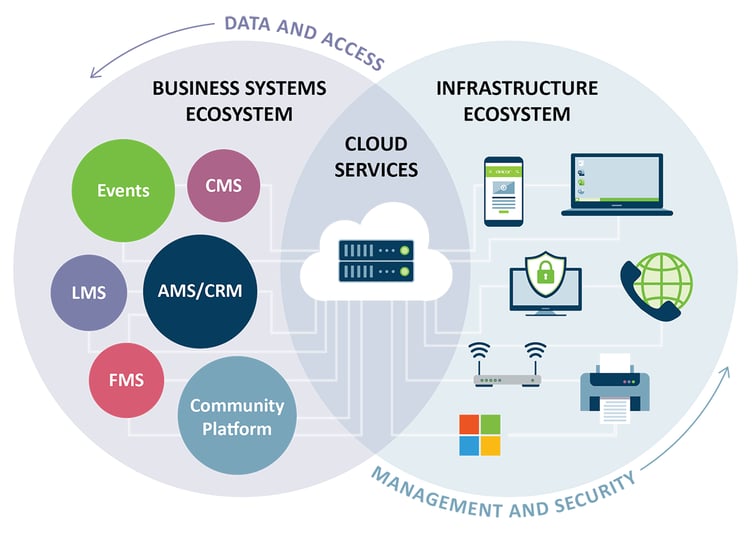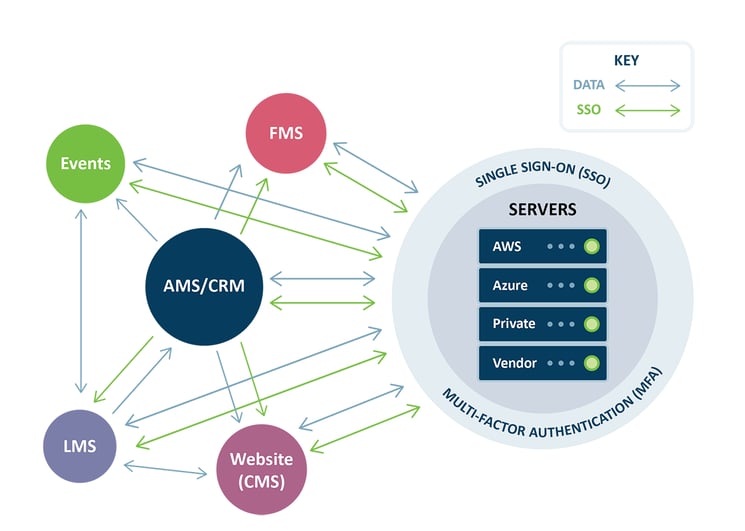What Is an Ecosystem?
Every organization has a variety of technology ecosystems, but not everyone is familiar with what those ecosystems are. Just like ecosystems in nature, technology ecosystems are made up of interconnected elements that connect with each other and the outside world. Here at DelCor, we like to break down the technology ecosystem into two smaller parts: a business system ecosystem and infrastructure ecosystem.
First, every organization has a business system ecosystem that consists of all the visible business systems used to serve members and customers, interact with the organization, and support internal operations. The infrastructure ecosystem is a less visible network layer below the business systems, services, and applications that keeps everything running. These ecosystems talk to each other to exchange information and keep data up to date across the organization.
Why Should We Understand Ecosystems?
While we’re hearing more buzz about ecosystems these days, the concept of the ecosystem is not new. What’s new is that more organizations are beginning to update their technology stack to include more specialized systems to fit their needs. The bulky, multipurpose systems of the past are losing popularity as more organizations opt to replace individual association management system (AMS) modules with best-of-breed systems designed to manage specific functions such as learning or virtual events.
However, while the technology available to connect systems is improving every day, organizations are still struggling to integrate these systems with each other to create one cohesive ecosystem.
At DelCor, we’re seeing clients run into problems because their ecosystems aren’t properly designed to handle specialized systems, so it’s more important than ever to evaluate your systems and make a plan for improving data flow between applications. The issue is not unique to larger organizations with multiple systems; this is also an issue for small staff associations with only an AMS, website, financial management system (FMS), and virtual event platform.
If you don’t put thought into how your systems fit together, you’ll deal with a lot of frustration as well as wasted time and money for both your staff and members. You won’t be able to take advantage of benefits from each of the specialized systems as well as any opportunities to predict and adjust to the needs of your members and staff with interconnected data.
Without a well-designed ecosystem, it is more difficult to identify, troubleshoot, and fix issues because you will have no idea where the source of the problem is, and it will be hard to know who to call if you don’t know what type of problem you’re dealing with. Luckily, you can avoid these issues in the first place if you think through and document your ecosystem; even a basic plan is a great start.
How Can We Build Better Ecosystems?
With the ever-evolving technology of today, it’s more viable than ever to optimize your ecosystem. In many cases, we now have the luxury of picking the best tool for each business to allow the AMS to focus on its core strength: managing members and key association functions. Even smaller ecosystems can benefit from this process. If you have limited resources, start by identifying the needs of your organization and then develop the best plan. For example, if your organization is focused on events and education, you may spend more resources to optimize these experiences.
With the growing number of available specialized systems and apps, it’s more important than ever to make sure you only have as many systems as you need while not duplicating efforts, and you want all your components to work together. Your ecosystem strategy will depend on the complexity of your business needs, your existing systems, staff size, budget, services, and IT resources.
Creating a more diverse and efficient ecosystem like this requires good highway management with the connections between systems, and this is where many projects fail. It’s crucial for business users to be aware of both the components of the system and the connections between systems so they can offer their support in developing and managing the ecosystem(s).
The best way to do this is to develop a map of your ecosystem and share it with the business users. Mapping can be as simple as drawing a diagram with a pen and paper or SmartArt within Microsoft 365 apps. Once you draw out all the systems and connections, you’ll be able to see how all your systems fit together and start taking the next steps to make your ecosystem as efficient and effective as possible.
What Are The Next Steps?
While not everyone needs to understand every technical aspect of their organization’s ecosystem, it’s important that business users have an idea about how their systems should work together so they can be involved in the decision-making when it comes to assessing their systems or selecting new ones. With the support of business users, organizations can make more informed decisions about how to ensure their systems will best meet their business goals.
Once you’ve mapped out your current ecosystem, here are some simple steps you can take to get started:
- Host a vendor summit: To ensure quality connections between your systems, you must maintain strong communication between your system vendors. This step is essential to make sure each part of your ecosystem works together.
- Involve staff members in the conversation: Business users have an ownership role to ensure the business system functionality is configured to meet staff and member needs. As such, business users must be familiar with your organization’s ecosystem. Show staff the value of maintaining a strong ecosystem to meet both technical needs and business needs and incorporate their feedback into the decision-making process.
- Make iterative improvements: As you make improvements to your ecosystem, allow time for staff and members to adjust to the changes and provide feedback. Make sure to identify manual or complex processes that may benefit from the features and functionality of the business system. This process should be part of the regular planning and maintenance process for your ecosystem so you can adapt as your business and technology systems change. To accomplish this, your technology team and business users need to be aligned in their goals and collaboration.
If you’re not feeling confident about making drastic changes to your organization’s systems, start with a basic plan and talk to your vendor partners. DelCor is ready to help you figure out your ecosystem strategy and use your resources effectively.

